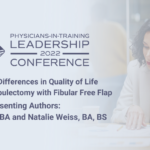Abstract | April 4, 2022
Age-related differences in quality of life following mandibulectomy with fibular free flap
Learning Objectives
- Understand the indications for a mandibulectomy with FFF;
- Describe the potential implications of mandibulectomy with FFF on QoL metrics;
- Identify the major differences in QoL outcomes between age groups.
Background: Mandibulectomy with fibular free flap (FFF) is a procedure involving removal of all or part of the mandible followed by reconstruction using revascularized donor bone from the fibula. It is frequently performed as part of management of a tumor involving or abuting the mandible. This can lead to significant problems with vital functions including feeding, speaking, and social interaction. Modern reconstructive efforts using microvascular reconstruction have the ability to mitigate many of these side effects. Fibula free flap reconstruction is often employed as a primary effort to restore mandible defects. There is a paucity of studies examining the outcomes of this type of reconstruction on the Quality of Life (QoL) of patients postoperatively. The University of Washington QoL (UW-QoL) survey asks patients to report on their functioning in 12 domains and rank them in order of importance.
Goals: The purpose of this review was to identify the differences in QoL metrics following mandibulectomy with fibular free flap between age groups.
Methods/Design: Six studies were identified which reported all domains of the University of Washington Quality of Life (UW-QoL) survey for self-reported QoL outcomes following mandibulectomy with FFF. Three papers focusing on older patient populations 1,2,3 were compared to three papers focusing on younger patient populations. 4,5,6 Student t-tests were performed with a cutoff for significance (alpha) set to 0.05 and a null of 0 difference between age groups.
Results/Findings: The cohort included 226 patients, 103 of whom were “younger” (mean = 35) and 123 “older” (mean = 50). One paper reported median instead of mean and was excluded from this value. Statistically significant results were as follows: The “younger” group reported worse recreation (65.54 vs 71.51, p = 0.0013), chewing (31.47 vs 48.27, p = 0.0001), saliva (62.38 vs 56.63, p = 0.0091), mood (64.38 vs 76.33, p < 0.0001), and anxiety (48 vs 67.72, p <0.0001); The “older” group reported worse appearance (65.35 vs 75.42, p < 0.0001), and taste (69.5 vs 74.55, p = 0.0155). Item importance was ranked similarly across ages.
Conclusions: This study demonstrates a difference between QoL measures based on age following mandibulectomy with FFF. These differences should be taken into consideration when selecting the appropriate reconstructive modality. Investigation into other factors affecting QoL differences is warranted.
References and Resources:
- Zhu J, Xiao Y, Liu F, Wang J, Yang W, Xie W. Measures of health-related quality of life and socio-cultural aspects in young patients who after mandible primary reconstruction with free fibula flap. World J Surg Oncol. 2013 Oct 2;11:250. doi: 10.1186/1477-7819-11-250. PMID: 24083617; PMCID: PMC3850790.
- Warshavsky A, Fliss DM, Frenkel G, Kupershmidt A, Moav N, Rosen R, Sechter M, Shapira U, AbuGhanem S, Yehuda M, Zaretski A, Yanko-Arzi R, Reiser V, Horowitz G.et al. Quality of life after mandibulectomy: the impact of the resected subsite. Int J Oral Maxillofac Surg. 2019 Oct;48(10):1273- 1278. doi: 10.1016/j.ijom.2019.02.013. Epub 2019 Mar 11. PMID: 30871848.
- Yang W, Zhao S, Liu F, Sun M. Health-related quality of life after mandibular resection for oral cancer: reconstruction with free fibula flap. Med Oral Patol Oral Cir Bucal. 2014 Jul 1;19(4):e414414-8. doi: 10.4317/medoral.19399. PMID: 24608209; PMCID: PMC4119320.
- Zhang X, Li MJ, Fang QG, Li ZN, Li WL, Sun CF. Free fibula flap: assessment of quality of life of patients with head and neck cancer who have had defects reconstructed. J Craniofac Surg. 2013 Nov;24(6):2010- 3. doi: 10.1097/SCS.0b013e3182a3057d. PMID: 24220393.
- Li X, Zhu K, Liu F, Li H. Assessment of quality of life in giant ameloblastoma adolescent patients who have had mandible defects reconstructed with a free fibula flap. World J Surg Oncol. 2014 Jul 8;12:201. doi: 10.1186/1477-7819-12-201. PMID: 25004805; PMCID: PMC4113126.
- Luo R, Li P, Li w, Li Y, Qi J. Original Measures of Health-related Quality of Life in Huge Ameloblastoma Young Patients after Mandible Reconstruction with Free Fibula Flap. Journal of Hard Tissue Biology 2014;23[2] (2014) ]:261-266.

